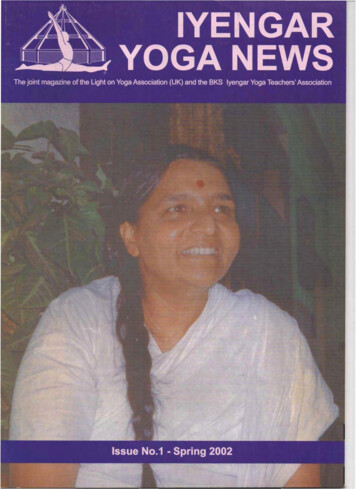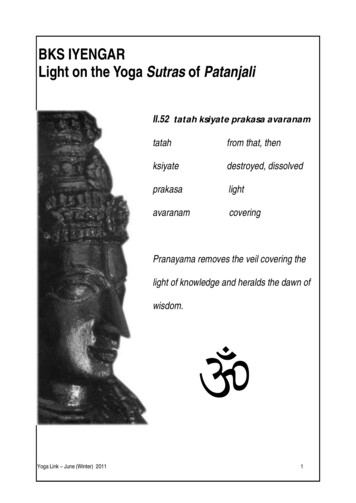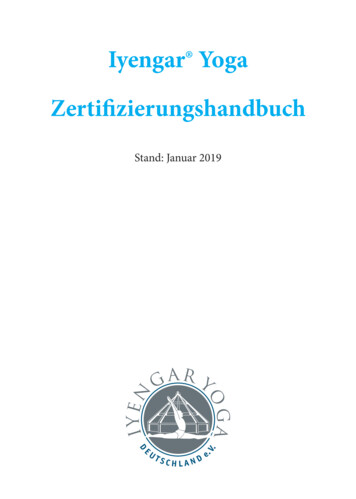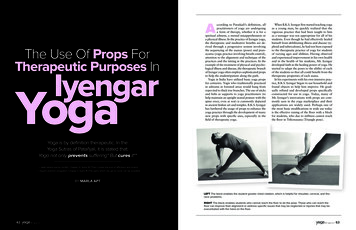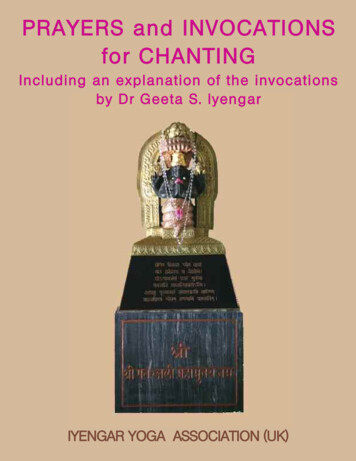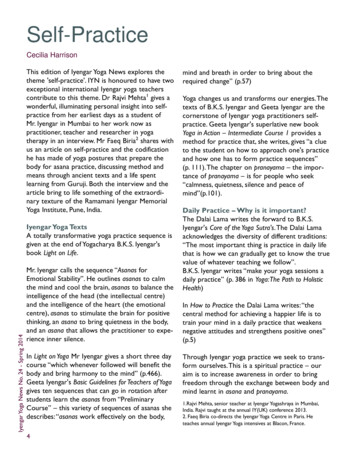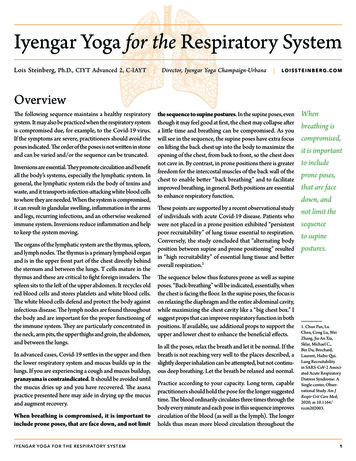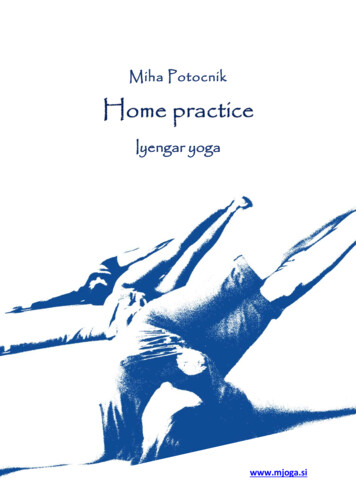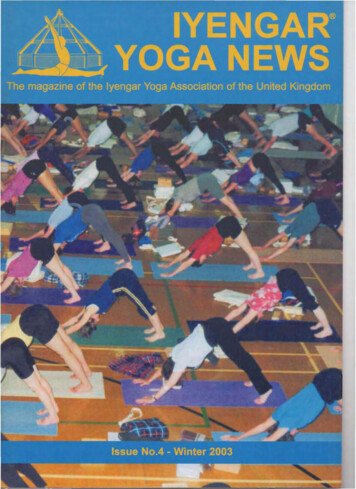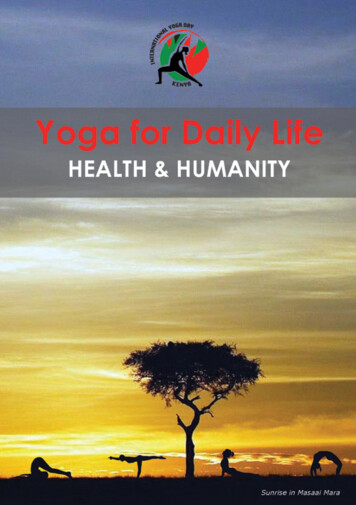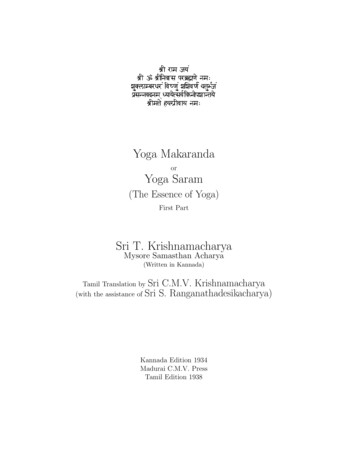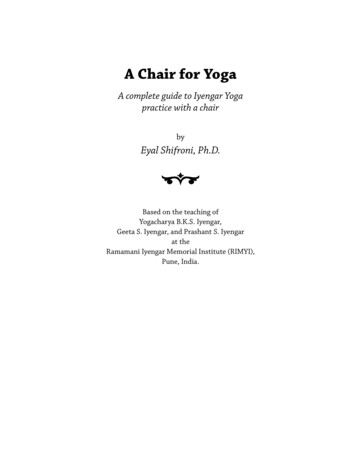
Transcription
A Chair for YogaA complete guide to Iyengar Yogapractice with a chairbyEyal Shifroni, Ph.D.Based on the teaching ofYogacharya B.K.S. Iyengar,Geeta S. Iyengar, and Prashant S. Iyengarat theRamamani Iyengar Memorial Institute (RIMYI),Pune, India.
Table of ContentsAcknowledgments and Gratitude . . viiIntroduction . ixChapter 1:Standing Asanas - Utthitha Sthiti . . 1Chapter 2:Sitting Asanas - Upavistha Sthiti . 37Chapter 3:Forward Extensions – Paschima Pratana Sthiti . 44Chapter 4:Twists –Parivritta Sthiti. 62Chapter 5:Inversions - Viparita Sthiti . 79Chapter 6:Backward Extensions – Purva Pratana Sthiti . 102Chapter 7:Abdominal Asanas – Udara Akunchana Sthiti. 145Chapter 8:Restorative –Visranta Karaka Sthiti. 149Chapter 9:Final Words. 154Appendix:A chair for all – a gentle practice sequence. 155v
Acknowledgments and GratitudeThe source of all the knowledge presented in this guide is myGuru, Yogacharia B.K.S Iyengar, the founder of the Iyengar Yogamethod. The use of chairs in Yoga practice was introduced byMr. Iyenger along with many other tools that he invented andadapted over the years. I wish to express my deep admirationand gratitude for him not only as my personal teacher, but alsofor making Yoga accessible to millions, enabling every personto benefit from the gift of Yoga. I wish also to thank my Guru,Mr. Iyengar, for devoting his precious time to reviewing themanuscript and suggesting valuable corrections. His feedback improved this guide tremendouslyand contributed to my confidence in publishing it.My initial interest in writing this guide was kindled during visits to Pune, while practicing with achair under the guidance of Prashant Iyengar at RIMYI.Geeta Iyengar's DVD: "The role of the chair in the yogi's life" ignited many of the ideas presentedin this guide.I wish to thank these three great teachers for introducing me to the world of Iyengar Yoga and forbeing a continuous source of knowledge and inspiration!I also wish to thank many other teachers, most notably Faeq Biria, Birjoo Mehta and JawaharBangera, who deepened and enriched my practice, with and without chairs.Gratitude is also due to my students who helped test and develop new ideas involving the use ofchairs during classes and workshops. I hope that they enjoyed this process as much as me!The writings of this guide have been a joint-project of all the teachers who teach with me at the centerin Zichron-Ya'akov (Israel). We all experimented and tried the chair-work with our students, andeach contributed his own ideas. I want to say thanks especially to: Michael Sela who went through my writings over and over, with endless patience and edited thetext. He helped me to formulate this guide and to express my ideas more concisely and clearly. Ravit Moar and Rachel Hasson who spent many hours modeling for the photos in this guide. Kym Ben-Ya'akov for contributing her talents both as a Yoga teacher and as an American nativeEnglish-speaker, as well as for using her hawk-eye to check the English in this guide.Thanks to Anat Scher for her willingness to model for the photos of the appendix. Special thanksalso to my student Ram Amit who volunteered to take the photos and who did such a dedicated andwonderful job! Thanks also to my sweet daughter, Ayelet who took some of the photos and edited allthe photos to give them a final touch.vii
And, last but not least, I want to thank my wife, Hagit. Without her love and support, this guide (andmany other things) could never have become real.Photography: Ram AmitGraphic Design: Einat Merimi Studio A.N.A.Text Editing: Michael Selaviii
IntroductionThis guide is a modest attempt to present how a chair can be used to deepen and enhance the practiceof Yogasasna. It was born out of the interest and enthusiasm expressed by my students during classesand workshops in which we explored various ways to use chairs. They requested me to document thiswork, so that they could continue to practice at home.We hope that this presentation will help practitioners, students and teachers make systematic useof chairs in their practice, thus helping to spread Iyengar Yoga for the benefit of all!The Use of PropsB.K.S. Iyengar developed a variety of equipment and accessories that enable every person to improveher/his asana practice and attain benefit from it. The main purposes of these "props" are to help thepractitioner:————Perform asanas which are difficult to perform independently;Achieve and maintain correct alignment during the practice;Stay longer and relax in challenging asanas, in order to attain their full benefit; andStudy and investigate the asanas to a greater depth.Props are indeed an important characteristic of Iyengar Yoga, but they should not be confusedwith its essence. Props are a means for achieving ends - such as alignment, stability, precision, andprolonged stays in asanas.This guide focuses on one such prop: chairs! It contains eight chapters, each dedicated to anotherfamily of asanas, and an appendix "A chair for all – a gentle practice sequence".The usages of the chair covered here, are intended to direct the awareness to different aspects ofthe asanas and to different parts of the body, in order to deepen and enhance the understanding ofthe asanas. Practitioners should be careful not to develop dependency on props; rather, props shouldbe employed intelligently in pursuit of a mature and mindful practice of asanas.What Type of Chairs Should be Used?The chair must be stable and sturdy and have a horizontal, square-shaped, flat seat at the appropriateheight (about 45 cm elevation from the floor). It is strongly recommended to use the folding metalchairs used in RIMYI and other Iyengar centers. These chairs are typically equipped with twohorizontal supportive metal rungs, one welded between the front legs and the other between therear legs. The backs of those chairs should be removed, in order to expose the framing of the backrestfor ease of gripping and for enabling moving through it.ix
Important Notes1. This guide is not intended for people suffering from special health problems. If you suffer from asevere health problem please seek guidance from a teacher who is certified to conduct therapeuticYoga classes.2. This guide is not intended for newcomers, but for people who have already acquired some basicknowledge and are familiar with the basic techniques of the presented asanas. For a completeguide on the techniques of asanas, please refer to Light on Yoga by B.K.S Iyengar, or other sourcessuch as Yoga – the Path to Holistic Health by the same author. Yoga in Action by Gita S. Iyengar is arecommended introduction to Yoga practice.3. The techniques shown here are based on the insights and principles of the Iyengar Method.Using the props without understanding these principles misses the point. Our motivation is tofacilitate and deepen the understanding of these principles. For this reason, a practitioner usingthis guide should have a solid foundation in Iyengar Yoga.4. For some of the advanced (and less familiar) poses, we have added a reference to the platedepicting the pose in Light on Yoga; for example, for Bhujangasana II (shown in plate 550) weadded the reference: LOY, Pl. 550.5. Finally, remember that no guide can include all the options of using chairs for Yoga. We encourageyou to practice in a playful manner; to explore, invent and discover other ways of enhancingyour Yoga practice with a chair! For comments and suggestions, please write to the author ateyal@theiyengaryoga.com.CAUTIONUsers of this guide must have a solid foundation in Yoga practice, preferably obtainedthrough regular classes with a certified Iyengar Yoga teacher. Some of the variations shownin this guide are advanced and should not be attempted without guidance and supervision.The author takes no responsibility for any injury or damage that may occur due to improperuse of the material presented.Enjoy your practice!x
Chapter 1: Standing AsanasAdho Mukha SvanasanaRaising the palm support in Adho Mukha Svanasana (downward facing dog) helps to shift the bodyweight to the legs and stay longer in the pose. In this way, even beginners can practice this importantasana and learn to work the legs, to extend the trunk, to open the chest, and so on.Variation 1: Raising the palmsThe following sequence presents three stages of moving into the pose, using a chair to raise the handsand provide resistance for the hands.Stage 1: Palms on seat Place a chair with its seatagainst a wall. Place the palms on theseat and step back intothe pose . The high support for the handsis very useful for people whoare stiff or have weak arms. Ithelps to shift the body weightfrom the arms to the legs.Stage 2: Palms on rung Now turn the chair sothat its front faces thewall. Place the base ofeach palm against therung of the chair. Open the palms andspread the fingers apart . Note that in stage 2, the forceyou apply on the chair mayfold it. To prevent this, placethe chair with its seat facing the wall. In this way, the chair will slide and fold slightly until it isstopped by the wall. Then, it will not fold anymore and you will be able to lean safely on it.3
A Chair for YogaStage 3: Palms on floor If possible ,take the handsfurther down and placethe palms on the floor. Place the chair's legsbetween the indexand thumb of thecorresponding hand. Spread the fingers wellwhile pushing against thelegs . Variation 2: Chair invertedThe chair can also be used when placed upside down in the following way: Turn the chair upside down and place its backrest against a wall. Place the palms on the bottom side of the seat (or hold the legs of the chair). Step back into the pose.Pushing the palms against aslanted surface helps to liftthe forearms and tighten theelbows. In addition, the legs ofthe chair support the forearmsand elbows. This is veryrelaxing for the arms and it isa boon for people who tend tohyper-extend the elbows.People with a wide shouldergirdle are advised to hold thelegs of the chair instead ofplacing the palms against theseat. This also helps to roll thearms from inside out (movethe triceps muscles closer tothe center line and the bicepsmuscles away from the centerline of the body).4
Chapter 1: Standing AsanasThe same placement of thechair can be used for AdhoMukha Virasana as shownhere:More on the use of the inverted chair will be presented later.Variation 3: Leaning on the chairIn this variation, the frontalside of the torso is leaning onthe chair. The heels are liftedand supported against a wall.It is recommended to placeblankets on top of the backrestand the seat in order to softenthe contact points . This variation is very usefulfor releasing and extendingthe back, especially afterbackbends practice. It givesrest and extension for theentire body. The abdomenis broadened and recededtoward the lower back.If needed, blocks can beused to support the palmsand/or feet . 5
A Chair for YogaThe following examples show the use of chairs forsupport and stability in several standing asanas,thus enabling longer stays and more attention tofiner details of the pose. It also enables stiff peopleto enjoy these poses. Generally speaking, the chaircan be used in three ways: behind, in front orinverted. Utthita TrikonasanaUtthita Trikonasana (Triangle pose) is a basicstanding pose. The chair can help in finding thecorrect alignment of the pose and in extending itsduration with reduced effort.Variation 1: Chair behindTo use the chair on the right side, do thefollowing: Place a chair behind you on the right side, withthe seat facing backwards (the backrest closerto you). Turn the right leg out and hold the backrestbehind the back with the left hand . Bend into the pose and place the right hand onthe seat . Using the hooking of the left hand, open thechest and turn it upward. If possible, bend further down and grip the legof the chair (as in ) or the horizontal rungclose to the floor.This variation, where the chair is behind, helpsto move the shoulders back – especially the leftshoulder (back leg shoulder) - and to turn thetorso upward.12
Chapter 1: Standing AsanasThe left hand is used to catch the backrest . A helper can give traction for the spine andneck . Variation 2: Chair in frontThis variation is helpful in case of a difficulty toreach the front leg ankle.To use the chair on the left side, do thefollowing: Place a chair in front of you and align theleft side of the chair with the left leg. Turn the left leg out. Bend into the pose, place the left hand onthe seat and hold the backrest with theright hand. Push the right hand to turn thechest.The chair supports and stabilizes the pose andhelps to broaden the pelvis and turn the chestupward.13
A Chair for YogaVariation 3: Foot on inverted chairHere, the chair is turned upside down andthe front foot is supported on the slantedbottom of the seat.To use the chair on the right side, do thefollowing: Invert the chair (legs up) and place thebackrest against a wall. Turn the right leg out and place the footon the inverted seat . Bend into the pose and hold the higherhorizontal rung. You can turn the palmout as in . This helps to roll the shoulderback and turn the chest upward. If possible, bend further and hold thelower horizontal rung, next to the rightleg .A back view i
Props are indeed an important characteristic of Iyengar Yoga, but they should not be confused with its essence. Props are a means for achieving ends - such as alignment, stability, precision, and prolonged stays in asanas. This guide focuses on one such prop: chairs! It contains eight chapters, each dedicated to another family of asanas, and an appendix "A chair for all – a gentle practice .
